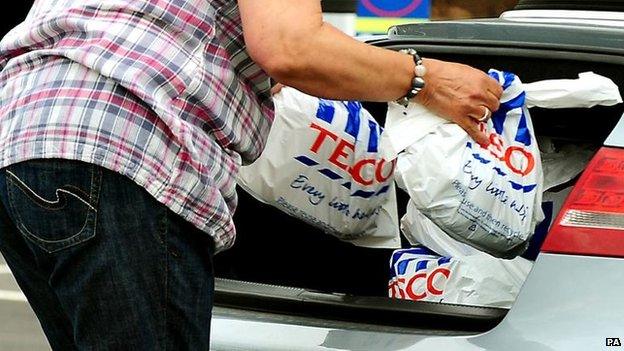Tesco: Keep calm and carry on?
- Published
- comments

Tesco is like a juggernaut with a puncture and a worrying rattle in the engine. It's still a pretty big lorry of course - let's not forget that it made £3.3bn of profits last year (admittedly down 6%) and still accounts for 29% of all supermarket trade in the UK (down from over 30%).
So why has there been the major fall in what are known as like-for-like sales - that's sales in its stores and online stripping out the effect of new stores opening (of which there are hardly any). Sales are down nearly 4%, and in the retail world that is significant. Tesco has not seen numbers this bad, it is admitting internally, for 20 years. One retail analyst from HSBC has said that the fall is equivalent to a million customers a week spending £25 less.
Some believe Tesco is becalmed in the middle ground, a no-man's land between Waitrose at the top end - sales up 6% - and Aldi and Lidl at the discount end, where sales are up 36% and 28% respectively.
But Asda, which may be expected to be suffering in the same way as one of the four big traditional retailers, is performing better with sales up. What's going on here?

Tesco boss Philip Clarke has warned sales figures will take time to improve
Tesco is suffering from what is known as the deflation effect - it recently announced cuts in prices for core products like milk and eggs. That has a negative effect on like-for-like sales, which are based on total revenue quarter by quarter. You have to sell a lot litres of milk at £1 (the new discount price) to gain the same revenue from selling milk at, say, £1.50. Any volume increase takes a while to be reflected in the numbers. Asda bit the bullet more than two years ago with price cuts and is now reaping the benefits.
Philip Clarke, Tesco's chief executive, has said that Tesco's figures will remain pretty grim for a while. The deflation effect can take a whole year to work its way through, meaning there will be some pretty tricky quarters ahead.
Mr Clarke is betting that rather than take on the discounters at their own game - a game he thinks Tesco will never win - it is better to offer "Tesco for everyone". So, you can buy a litre of milk from Tesco, you can get a pretty cheap own-label tablet (the Tesco Hudl), you can have a coffee at a Harris + Hoole cafe, you can go to a Giraffe restaurant with your children, you can get an ISA from Tesco's own bank, online they sell not just Tesco products via "marketplace" but are plotting to be a competitor to Amazon by selling other retailers' goods as well. They have an online entertainment service, Blinkbox, a mobile phone service, 16 million Clubcard customers to cross-sell to, a huge petrol business . . . the list is endless.
Mr Clarke says that a long term focus on a wide range of products is the way to turn the business around. Of course, the core offer - the food - must also be up to standard and at the right price. Mr Clarke says that the board are wholly signed up to the strategy. Internally his mantra, I have been told, is "keep calm and carry on". The retail industry is still re-finding its feet after the 2008 crash. Tesco, Mr Clarke admits privately, was too slow to change.
His critics say that by the end of the year like-for-like sales will have to be on the way up if the chief executive is to feel comfortable in his job. Revamped stores will have to show growth. Online, a small proportion (around 7%) of overall sales, will need to show continued, profitable progress. The international businesses will have to improve.
With the share price under pressure (down 20% in a year) the big question will be whether the share holders - the people that own the company - will give Mr Clarke the time he says he needs.